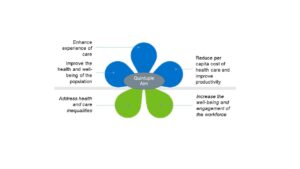As the idiom purports the certainty of 'death and taxes', two others, it could be argued, follow on closely behind these days: digitalisation and complexity.
It could also be said that our health, individually and collectively, impacts and is impacted by all of these 'certainties'. Advancements in the (tax funded) health and care system stave off death, with digital driving the improvements in many cases, often resulting in longevity but with complex needs from accumulated chronic conditions.
These changes in our health and the challenges it presents to the health and care system are now severe. For a system originally designed for acute, reactive treatment of the sick, the current presenting needs of an ageing, multi-morbid population require a different focus of approach and a pivot towards an anticipatory, preventive model of care and support.
With the increasing speed of digitalising the world, both at once expanding our networks and shrinking the separation between us, we have never been more interconnected and interdependent as individuals and societally. This creates an ever-increasing intertwined complex set of determinants driving health outcomes including education, employment, income, social interactions, environment, and support services.
It is this digitalisation and the accompanying improvements in access and ability to utilise the generated data that underpins the Population Health Management approach within Essex. Population Health Management (PHM) is a way for health and care systems to deliver value through better management of limited resources. For example, using insight from record level, linked data to go beyond the traditional universal delivery of care and support, to identify cohorts or groups of the population with shared, specific characteristics. To then be able to design and deliver proactive interventions to either prevent, reduce, or delay disease/condition progression, improve the experience (of the person and workforce) and quality of any care needed, all resulting in better outcomes for both the individual, population and system. This approach supports the quintuple aim of a health and care system:

Through a Population Health Management approach, the focus can shift from just treating people once they become sick to a pre-emptive model in which emphasis is on promoting well-being. This empowers cohorts of the population to be supported in ways that address the social determinants of their health, improves management of health needs holistically (rather than a disease at a time) and highlights inequity of services and outcomes between and within population groups. This shift in focus using PHM enables new resourcing options to be explored to incentivise a more proactive care model, shifting the system's resources to more preventative work can increase the efficiency of the system through preventing, delaying, or reducing the more costly treatment side of the equation.
By using modern digital and data architecture along with the latest analytical methods, insight is generated that allows for a more nuanced, personalised and targeted planning of services and support structures. Providing an understanding of not only past and present demand and need but also forecasting future needs. These could be needs arising from behaviours (smoking, excess alcohol, poor nutrition, being sedentary), levels of connectiveness (loneliness, isolation) or social drivers (housing, employment, income), all known causes of poor health. By understanding the pathways of these determinants and the cohorts of the population most at risk at different life points, 'upstream' interventions put in place months, years or even decades earlier can prevent or reduce their impact.
However, these are often multi-faceted and complex issues that require, co-ordinated and sustained effort at many societal levels. This is where the numerous national policies emphasising prevention and early intervention along with the new Integrated Care Systems (ICS) provide the structure for this PHM work. ICSs have PHM at the heart of their remit, enabled by bringing together partners from health services, local authorities, voluntary sector, police, fire and many more. Through collective action across multiple partners, including residents, differences can be made to the outcomes for individuals and communities, harnessing the power of all involved to tackle the complex interdependences at the varying levels of an area, neighbourhoods, districts and system wide.
Integrated Care Systems across the country, including the three linked to Essex, have participated in a national programme to support them in developing their approach to PHM. Linked data and other insights were used to identify cohorts experiencing worse outcomes in their health, several Primary Care Networks and a district level 'place' in each system took part. Further details of the pilot projects and the full PHM programmes across the Essex systems can be found at the below links:
- Mid and South Essex Health and Care Partnership - M&SE Local PHM
- Suffolk and North East Essex Integrated Care System - Can Do Health & Care - Thinking Differently - PHM
- Hertfordshire and West Essex Integrated Care System - Population Health Management | A Healthier Future
At Essex County Council we are working as a stakeholder in each of the systems to support this new approach. ECC is helping to drive the changes through investing in both its capacity and capability to generate insight for PHM. New dedicated health and care analytical roles and data flows are being established along with the digital architecture to provide the foundation. With this new resource and focus, ECC can play its role as a key partner in helping to embed PHM across the health and care systems. The adverts for these new analytical positions, which will have an emphasis on supporting and developing PHM across Essex, are available to view here.
PHM is a key enabler of health and care systems to improve the experiences and outcomes of the populations they serve, with the 'certainties' in life, key driving forces behind it; promoting long and healthy lives supported by cost effect and efficient services.
For further information, The King's Fund (kingsfund.org.uk) have 2 excellent animation explainers: